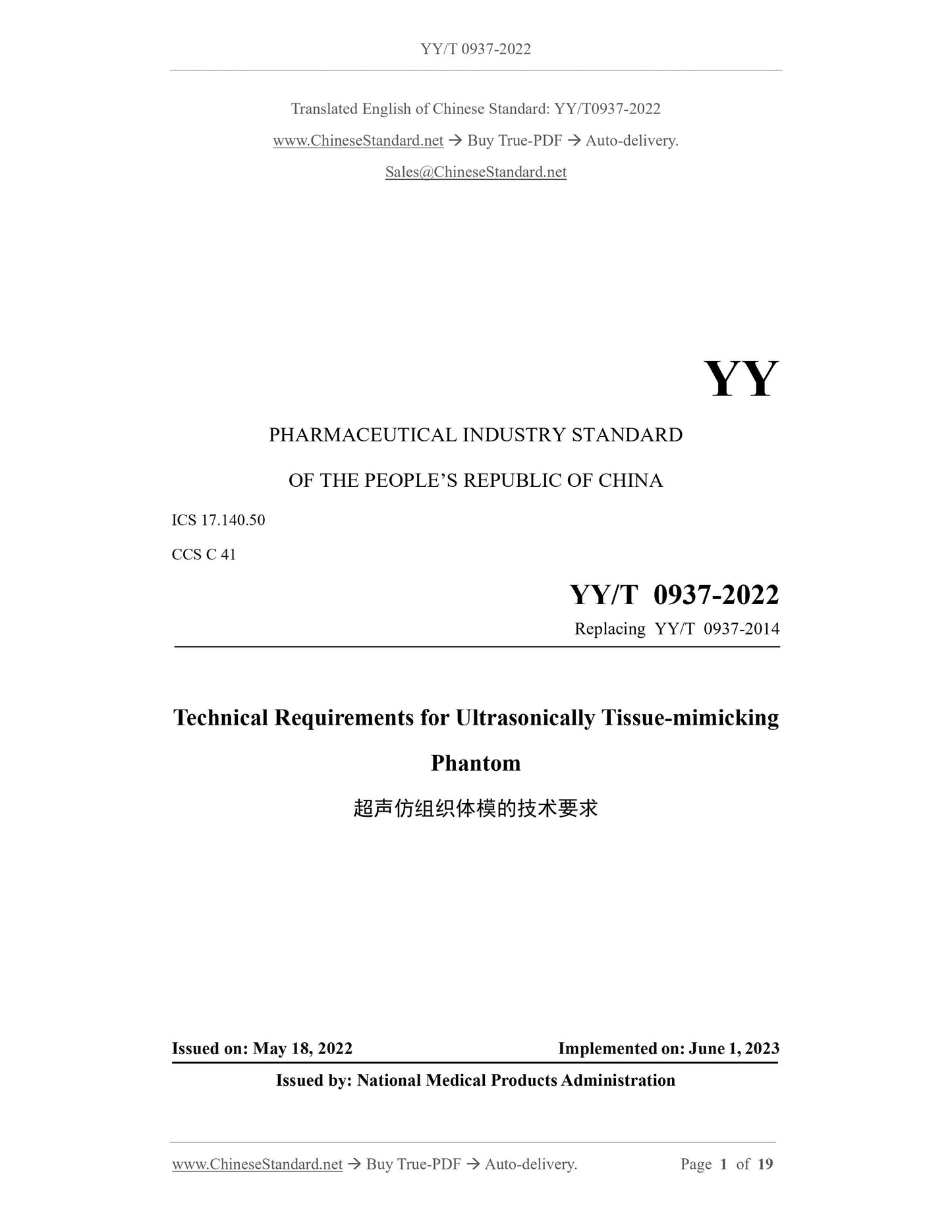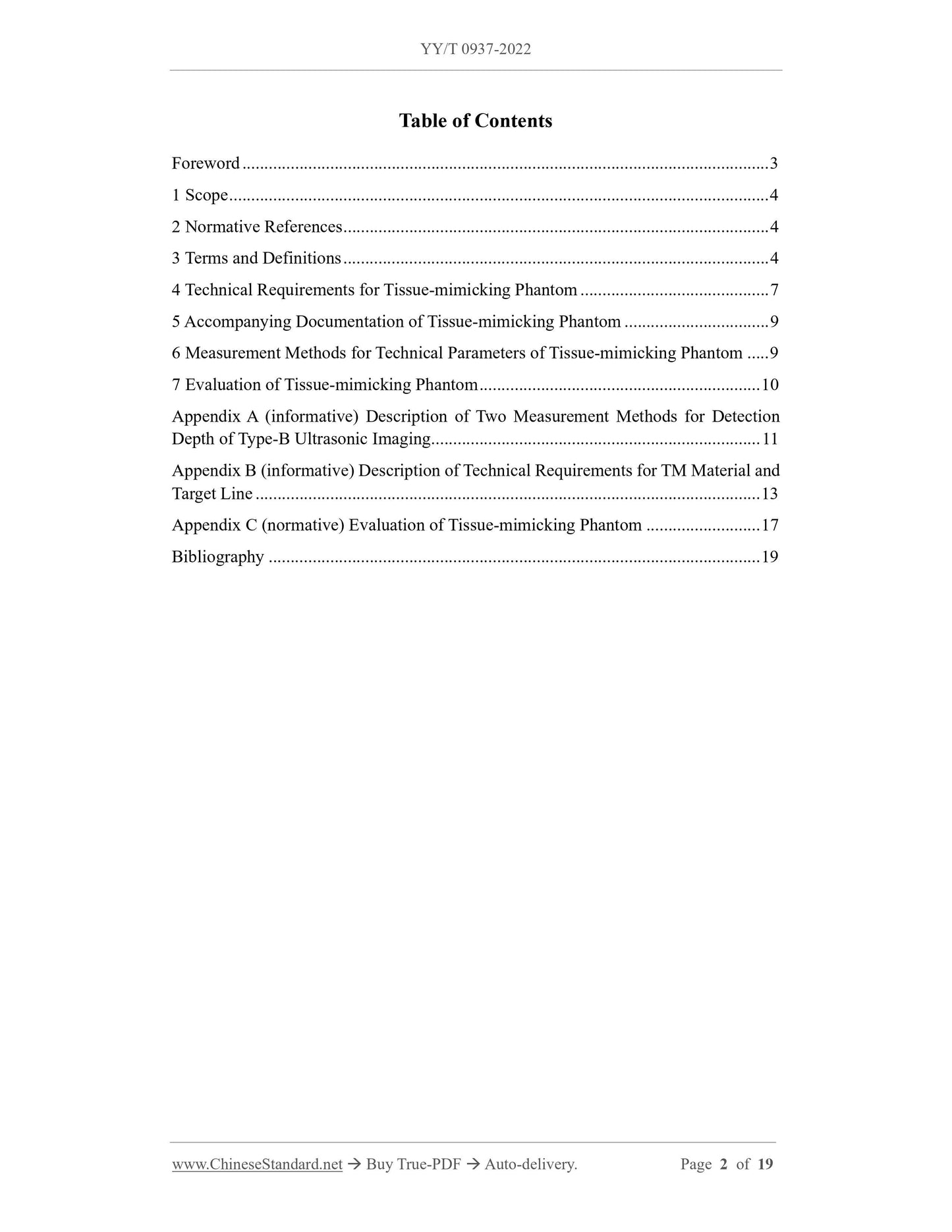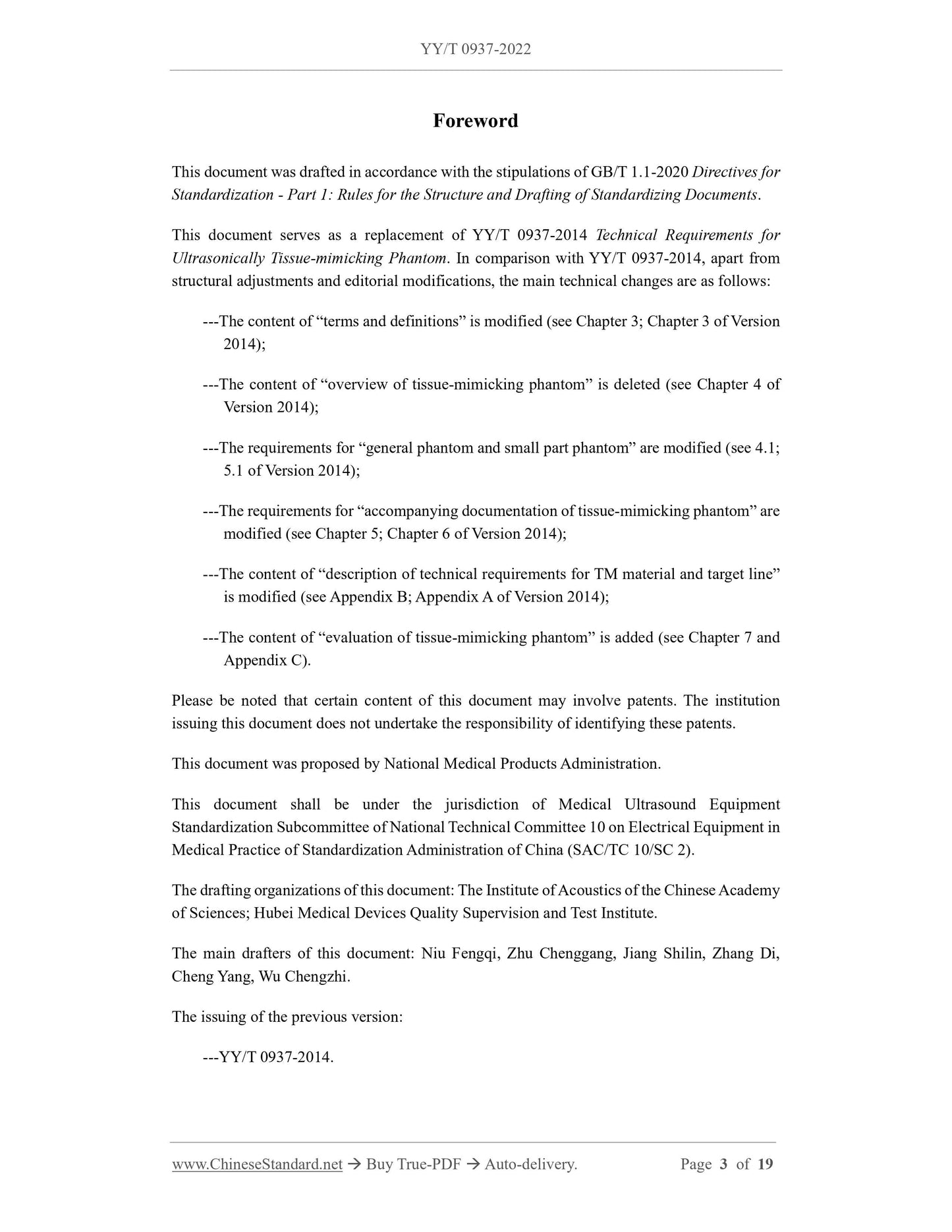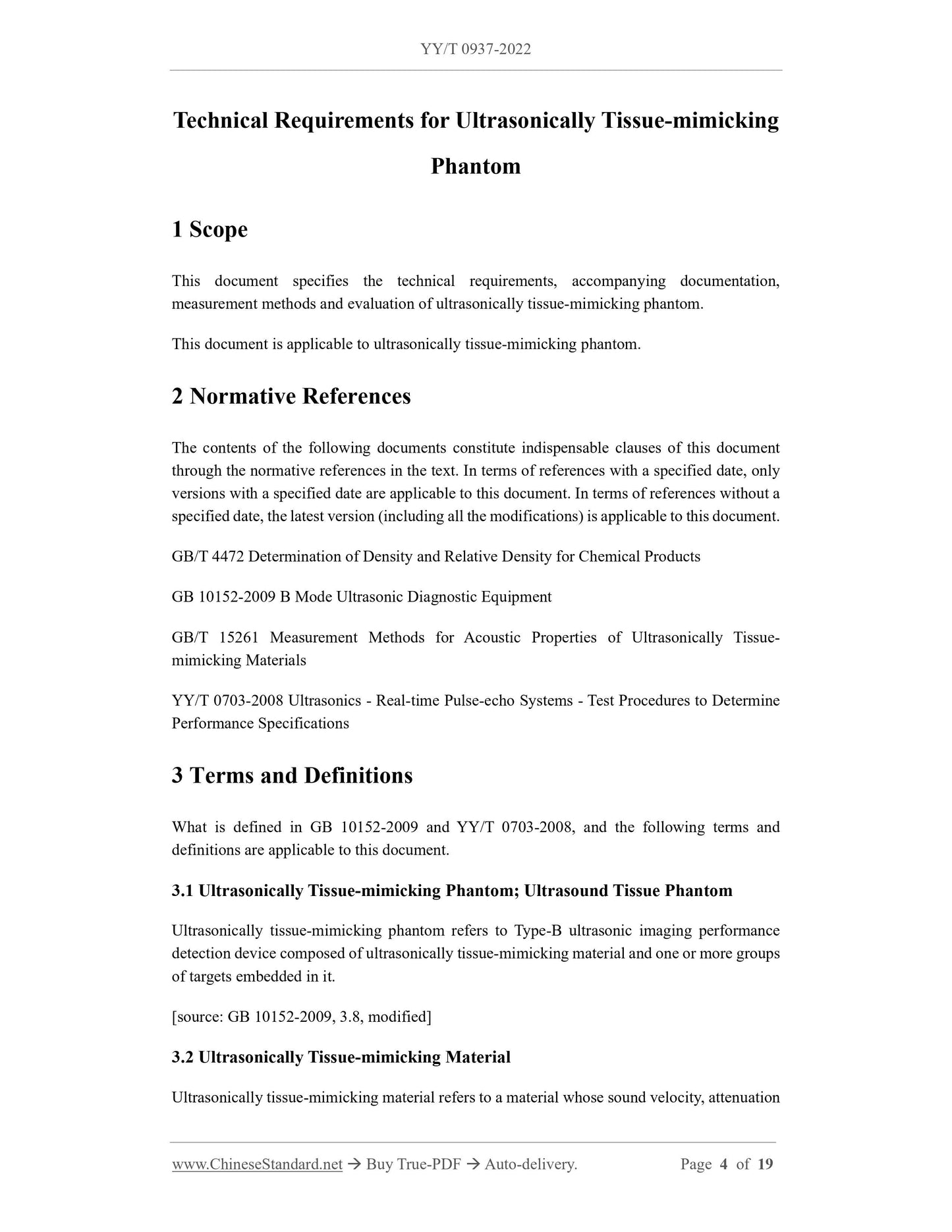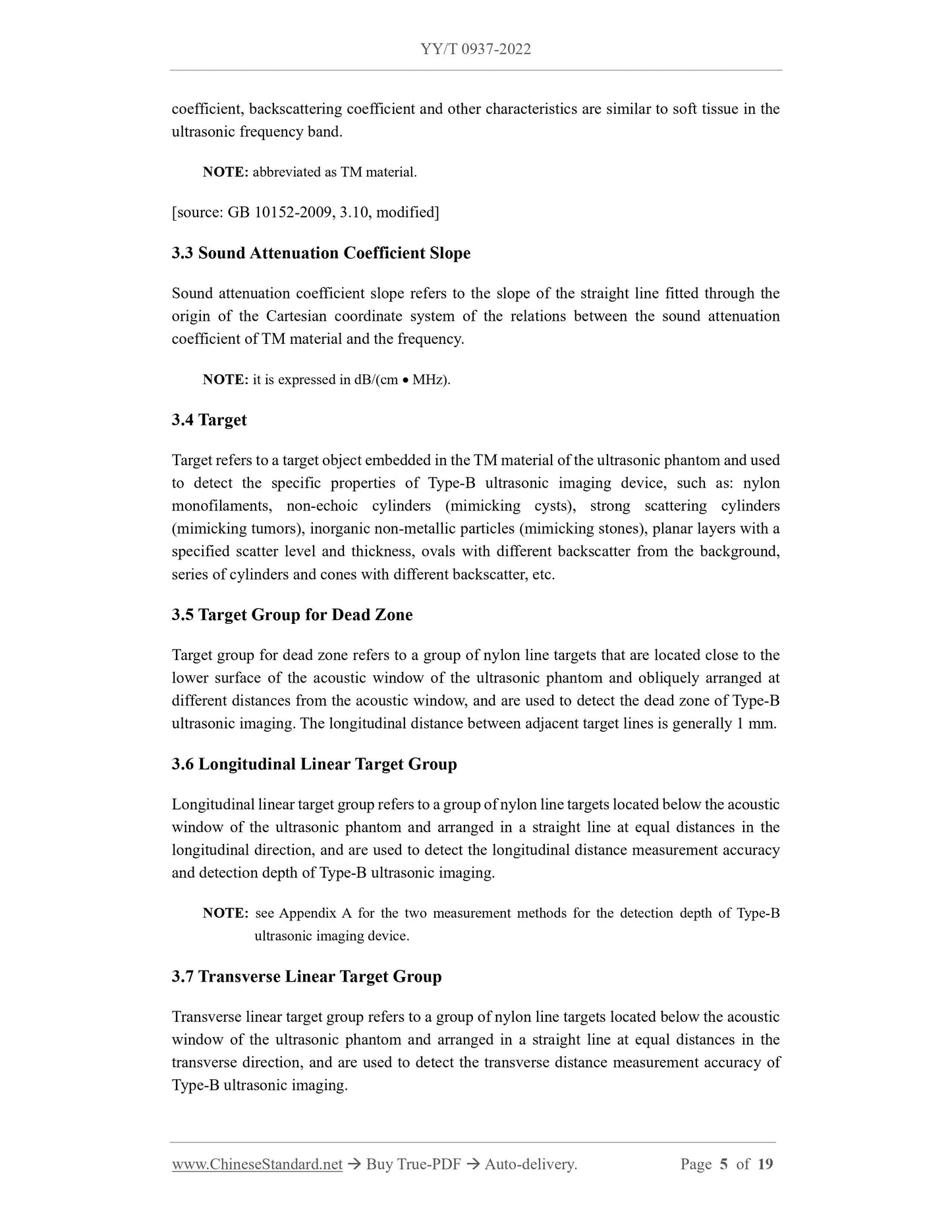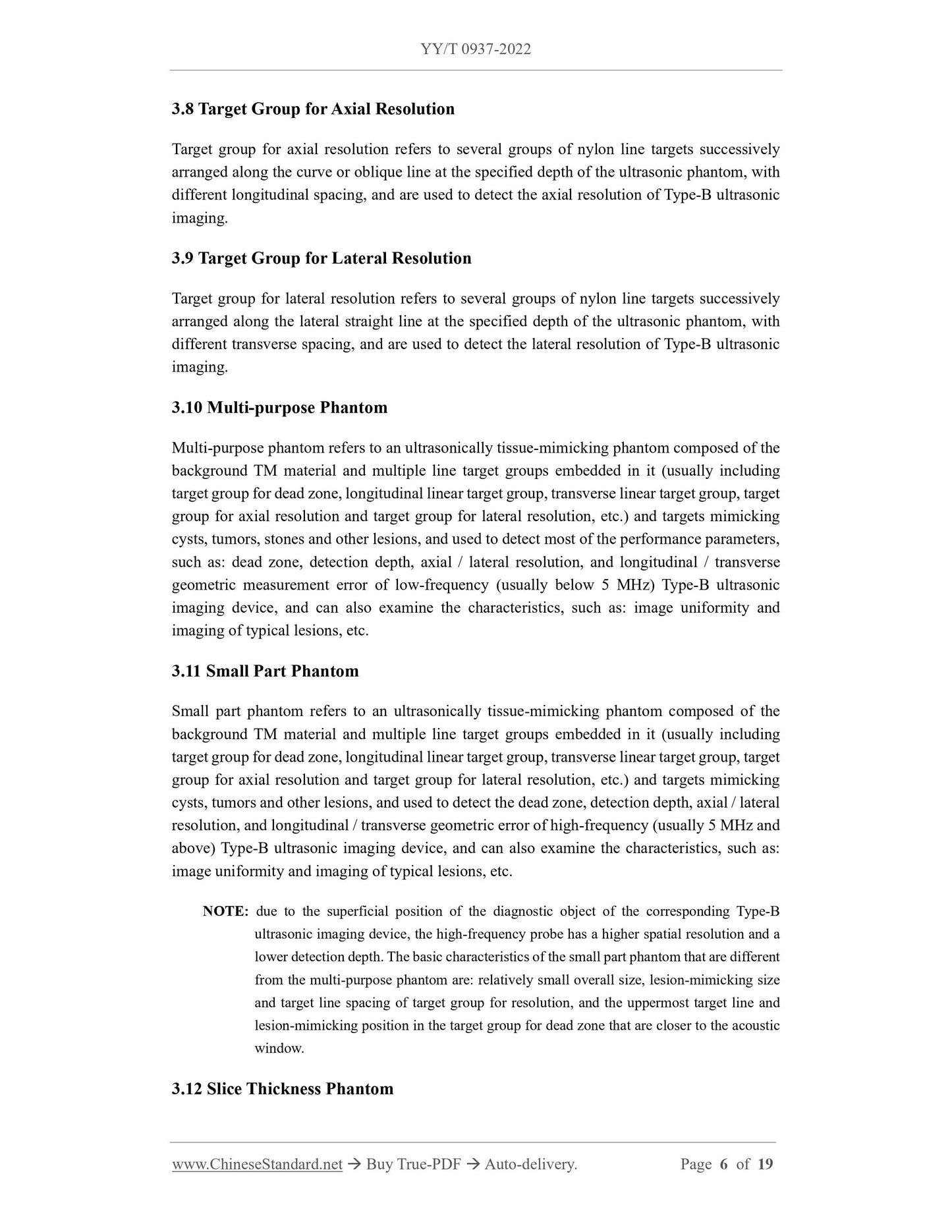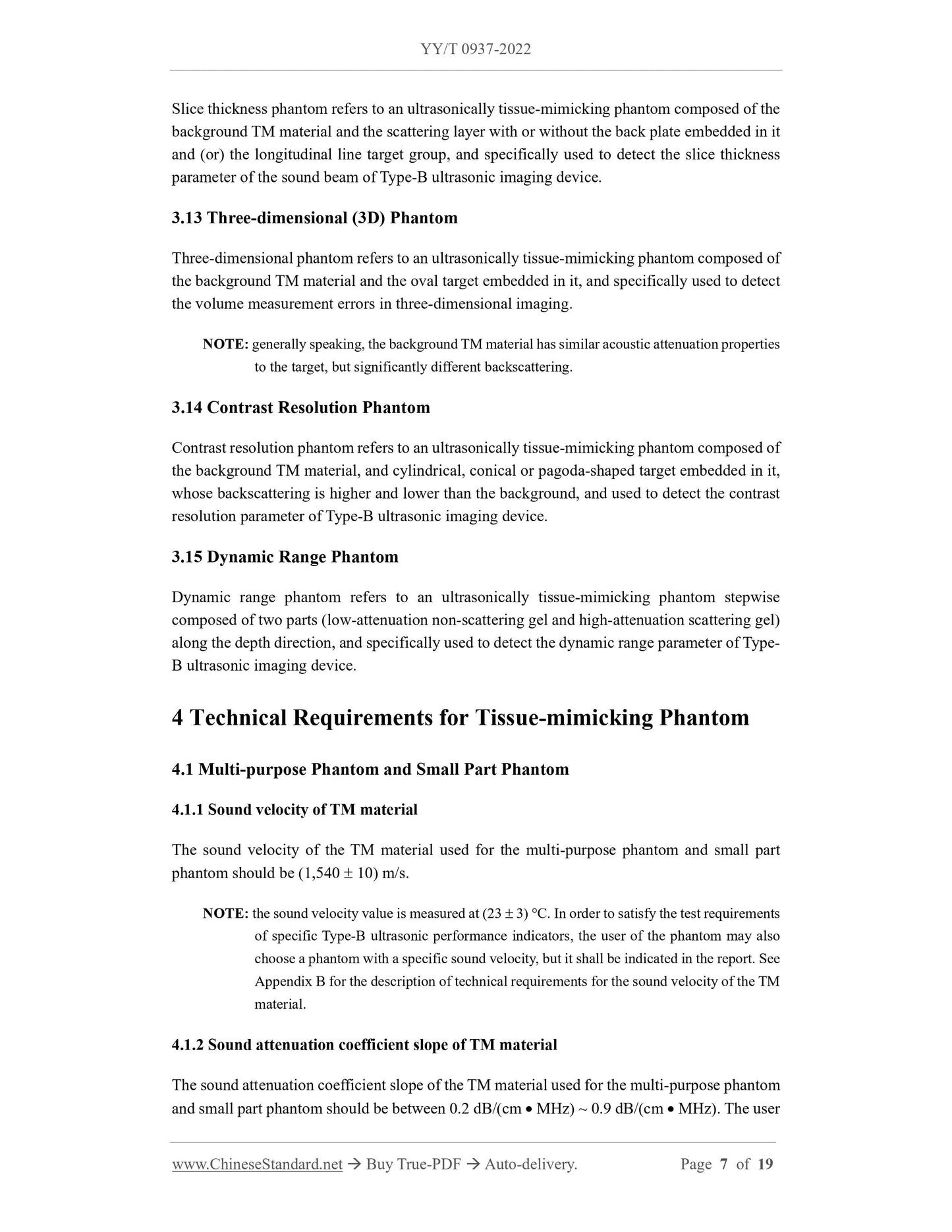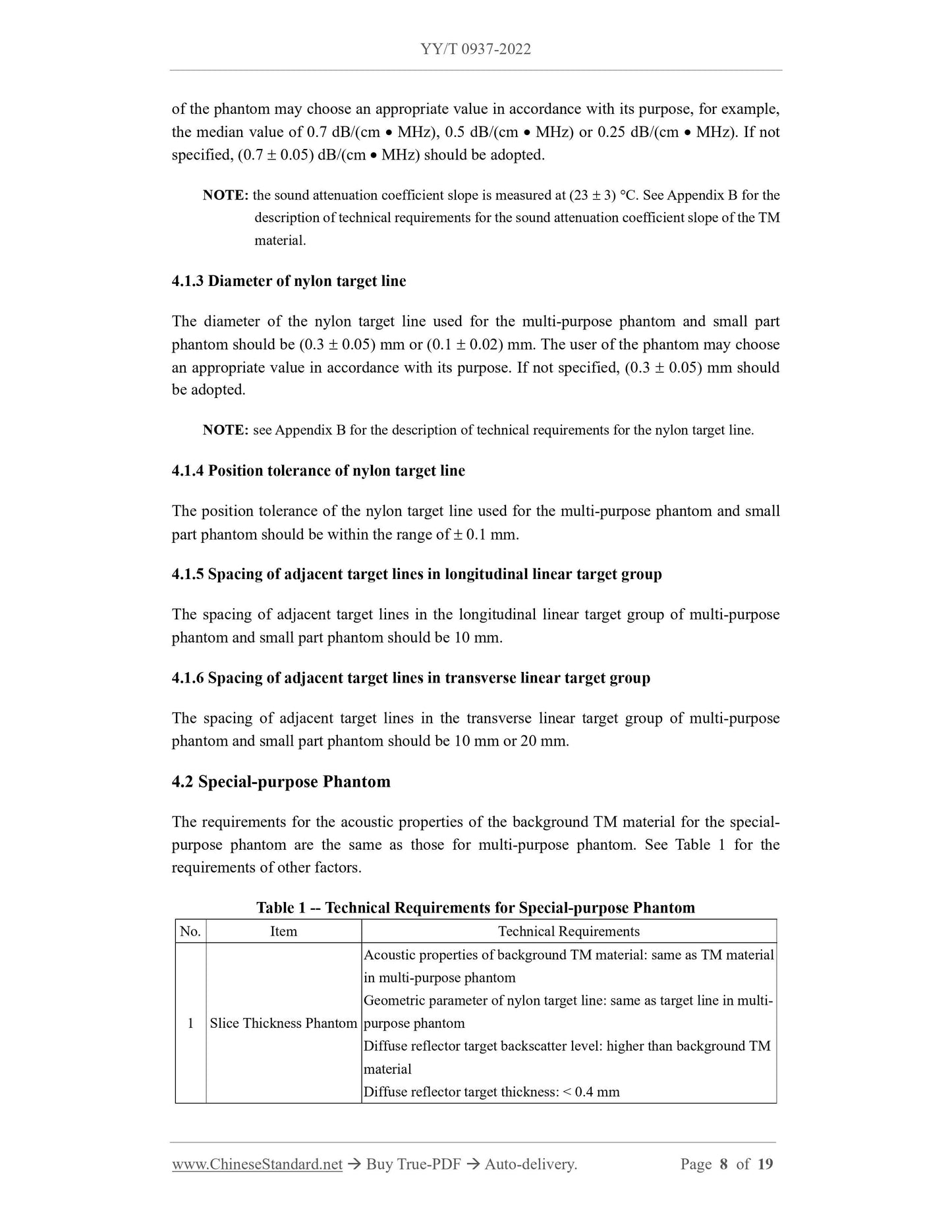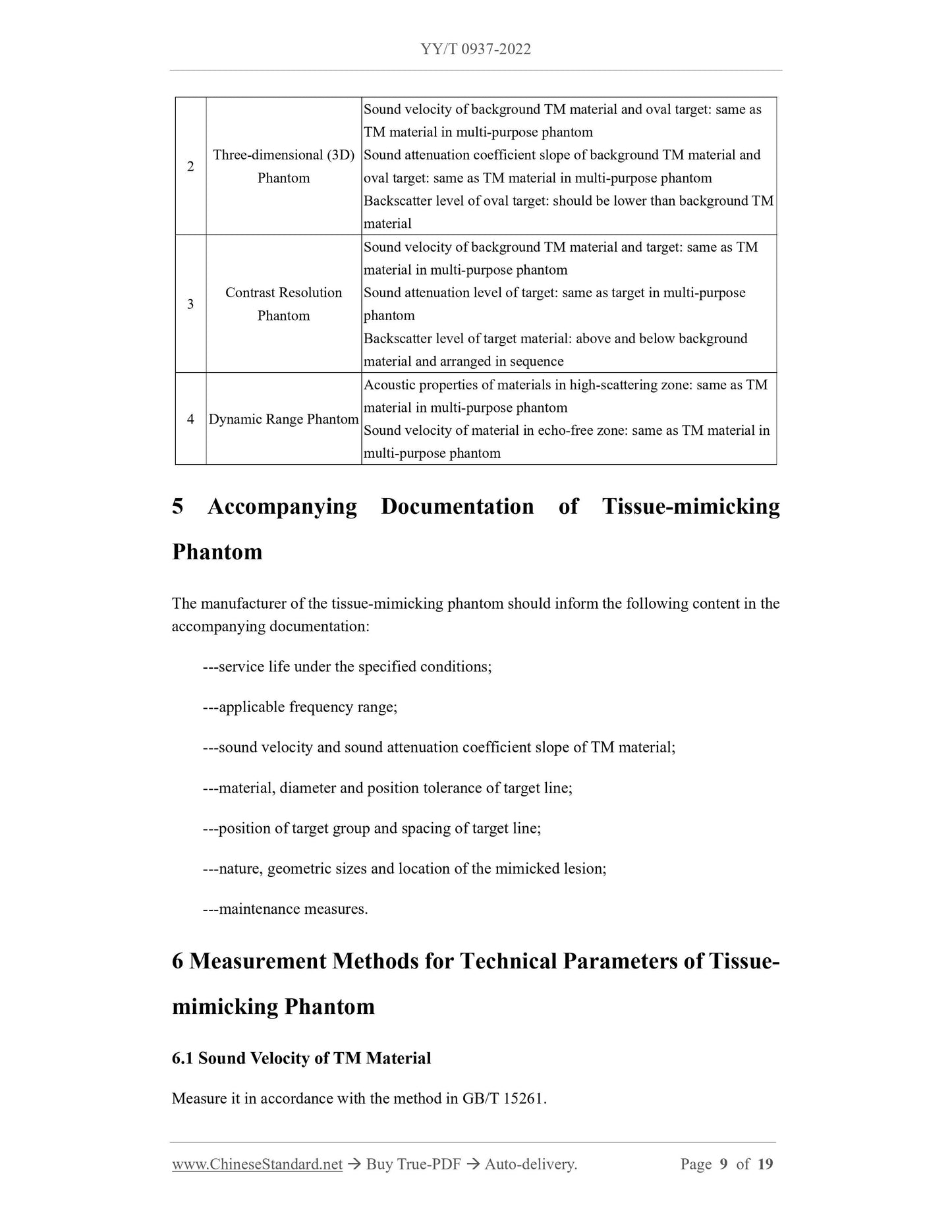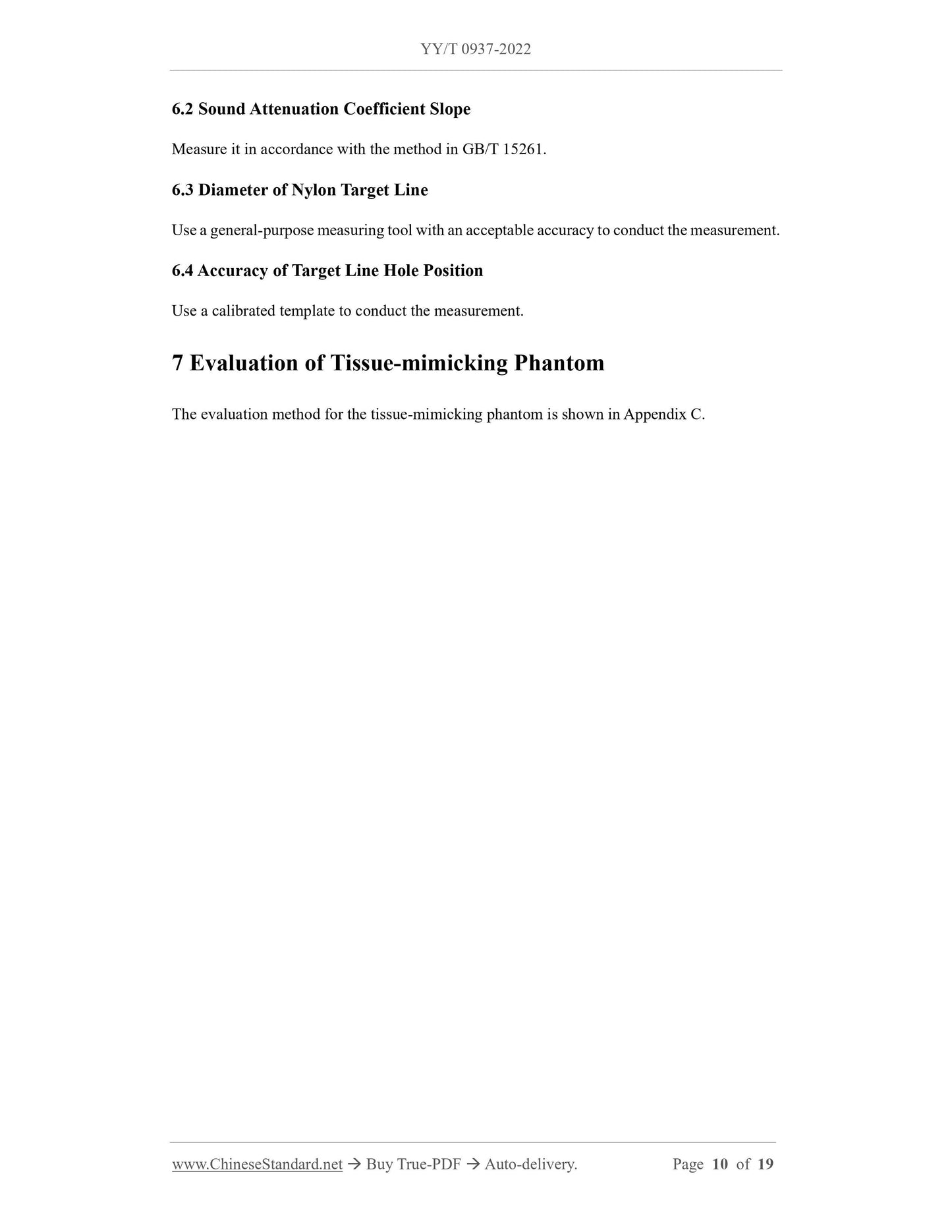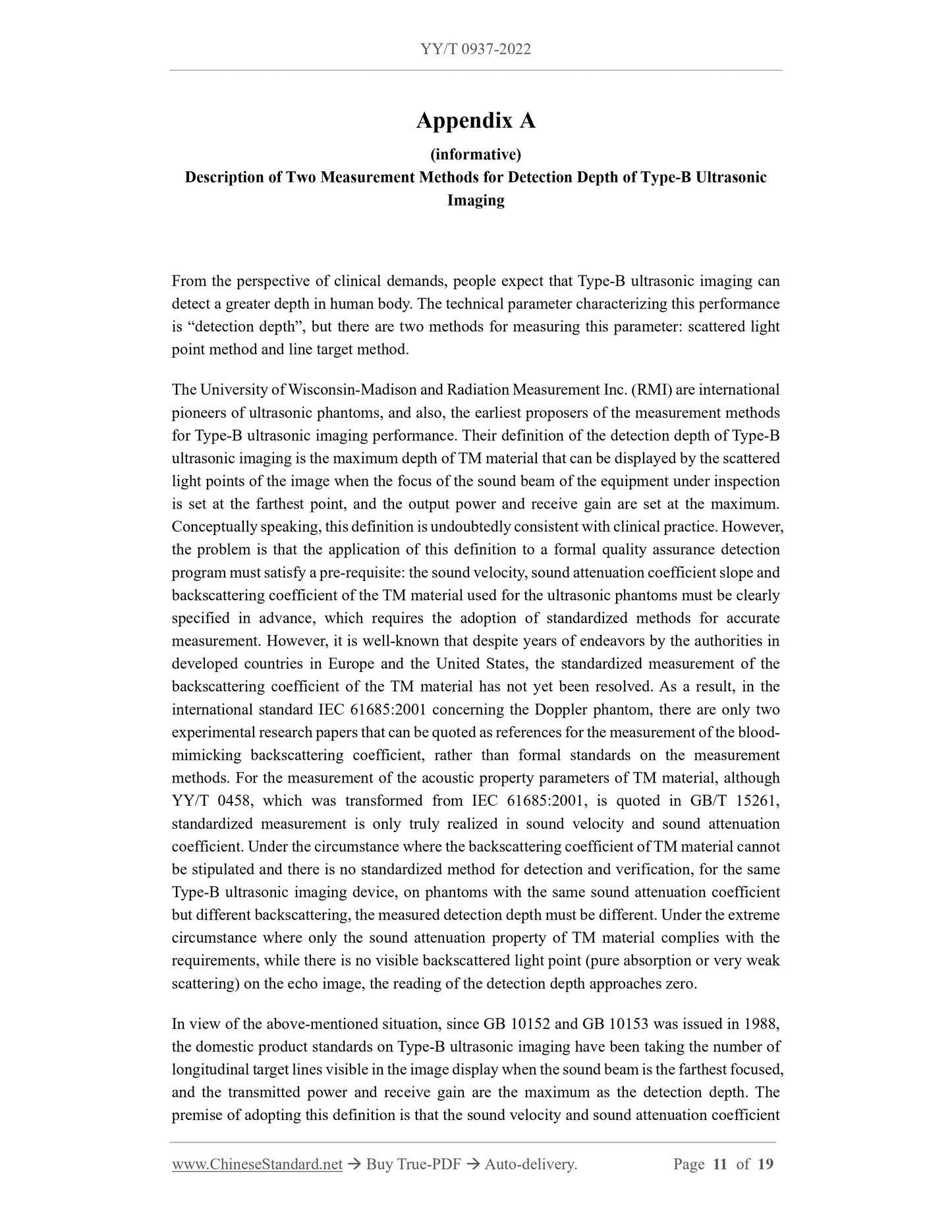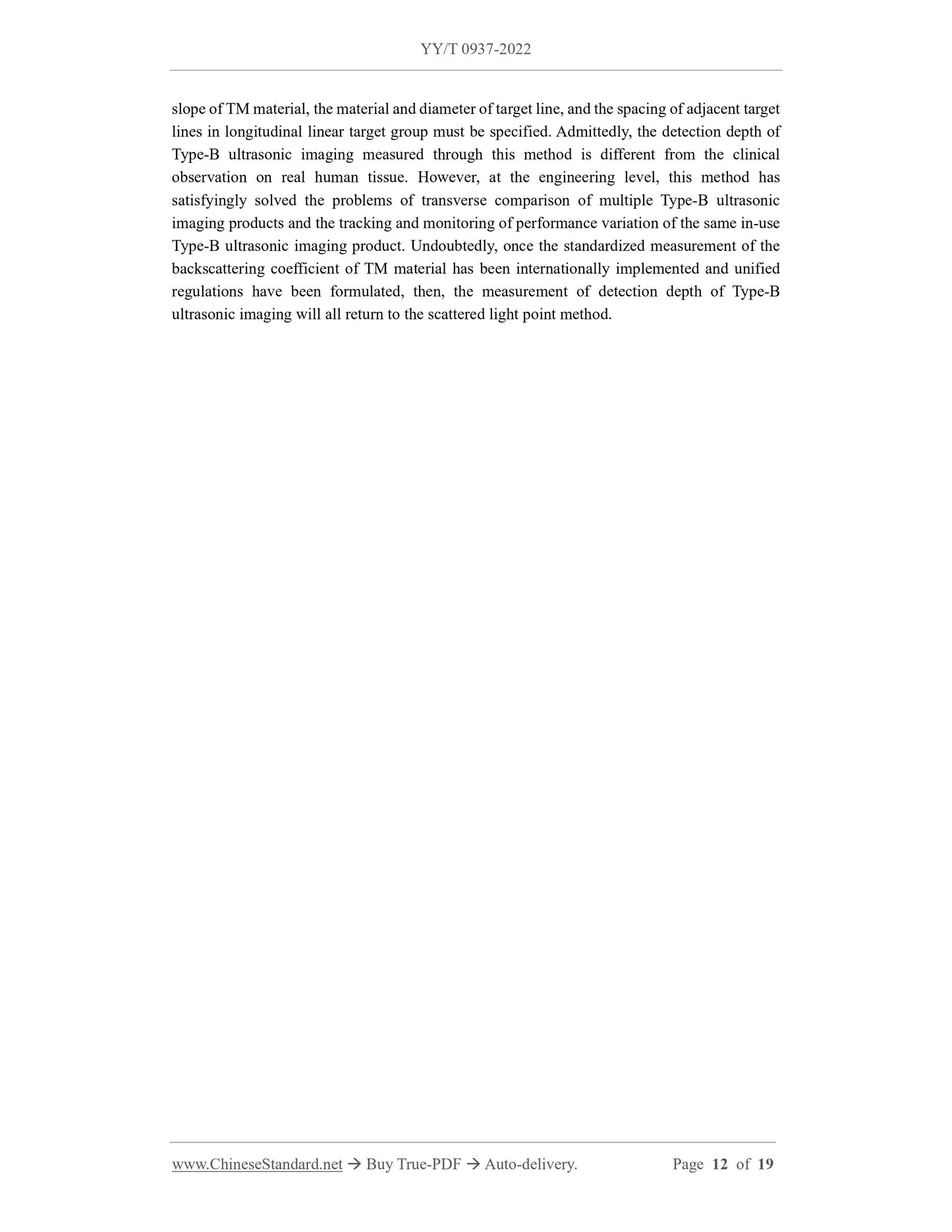1
/
de
12
PayPal, credit cards. Download editable-PDF & invoice in 1 second!
YY/T 0937-2022 English PDF (YYT0937-2022)
YY/T 0937-2022 English PDF (YYT0937-2022)
Prix habituel
$230.00 USD
Prix habituel
Prix promotionnel
$230.00 USD
Prix unitaire
/
par
Frais d'expédition calculés à l'étape de paiement.
Impossible de charger la disponibilité du service de retrait
Delivery: 3 seconds. Download true-PDF + Invoice.
Get QUOTATION in 1-minute: Click YY/T 0937-2022
Historical versions: YY/T 0937-2022
Preview True-PDF (Reload/Scroll if blank)
YY/T 0937-2022: Technical requirments for ultrasonically tissue-mimicking phantom
YY/T 0937-2022
YY
PHARMACEUTICAL INDUSTRY STANDARD
OF THE PEOPLE’S REPUBLIC OF CHINA
ICS 17.140.50
CCS C 41
Replacing YY/T 0937-2014
Technical Requirements for Ultrasonically Tissue-mimicking
Phantom
ISSUED ON: MAY 18, 2022
IMPLEMENTED ON: JUNE 1, 2023
Issued by: National Medical Products Administration
Table of Contents
Foreword ... 3
1 Scope ... 4
2 Normative References ... 4
3 Terms and Definitions ... 4
4 Technical Requirements for Tissue-mimicking Phantom ... 7
5 Accompanying Documentation of Tissue-mimicking Phantom ... 9
6 Measurement Methods for Technical Parameters of Tissue-mimicking Phantom ... 9
7 Evaluation of Tissue-mimicking Phantom ... 10
Appendix A (informative) Description of Two Measurement Methods for Detection
Depth of Type-B Ultrasonic Imaging ... 11
Appendix B (informative) Description of Technical Requirements for TM Material and
Target Line ... 13
Appendix C (normative) Evaluation of Tissue-mimicking Phantom ... 17
Bibliography ... 19
Technical Requirements for Ultrasonically Tissue-mimicking
Phantom
1 Scope
This document specifies the technical requirements, accompanying documentation,
measurement methods and evaluation of ultrasonically tissue-mimicking phantom.
This document is applicable to ultrasonically tissue-mimicking phantom.
2 Normative References
The contents of the following documents constitute indispensable clauses of this document
through the normative references in the text. In terms of references with a specified date, only
versions with a specified date are applicable to this document. In terms of references without a
specified date, the latest version (including all the modifications) is applicable to this document.
GB/T 4472 Determination of Density and Relative Density for Chemical Products
GB 10152-2009 B Mode Ultrasonic Diagnostic Equipment
GB/T 15261 Measurement Methods for Acoustic Properties of Ultrasonically Tissue-
mimicking Materials
YY/T 0703-2008 Ultrasonics - Real-time Pulse-echo Systems - Test Procedures to Determine
Performance Specifications
3 Terms and Definitions
What is defined in GB 10152-2009 and YY/T 0703-2008, and the following terms and
definitions are applicable to this document.
3.1 Ultrasonically Tissue-mimicking Phantom; Ultrasound Tissue Phantom
Ultrasonically tissue-mimicking phantom refers to Type-B ultrasonic imaging performance
detection device composed of ultrasonically tissue-mimicking material and one or more groups
of targets embedded in it.
[source: GB 10152-2009, 3.8, modified]
3.2 Ultrasonically Tissue-mimicking Material
Ultrasonically tissue-mimicking material refers to a material whose sound velocity, attenuation
3.8 Target Group for Axial Resolution
Target group for axial resolution refers to several groups of nylon line targets successively
arranged along the curve or oblique line at the specified depth of the ultrasonic phantom, with
different longitudinal spacing, and are used to detect the axial resolution of Type-B ultrasonic
imaging.
3.9 Target Group for Lateral Resolution
Target group for lateral resolution refers to several groups of nylon line targets successively
arranged along the lateral straight line at the specified depth of the ultrasonic phantom, with
different transverse spacing, and are used to detect the lateral resolution of Type-B ultrasonic
imaging.
3.10 Multi-purpose Phantom
Multi-purpose phantom refers to an ultrasonically tissue-mimicking phantom composed of the
background TM material and multiple line target groups embedded in it (usually including
target group for dead zone, longitudinal linear target group, transverse linear target group, target
group for axial resolution and target group for lateral resolution, etc.) and targets mimicking
cysts, tumors, stones and other lesions, and used to detect most of the performance parameters,
such as: dead zone, detection depth, axial / lateral resolution, and longitudinal / transverse
geometric measurement error of low-frequency (usually below 5 MHz) Type-B ultrasonic
imaging device, and can also examine the characteristics, such as: image uniformity and
imaging of typical lesions, etc.
3.11 Small Part Phantom
Small part phantom refers to an ultrasonically tissue-mimicking phantom composed of the
background TM material and multiple line target groups embedded in it (usually including
target group for dead zone, longitudinal linear target group, transverse linear target group, target
group for axial resolution and target group for lateral resolution, etc.) and targets mimicking
cysts, tumors and other lesions, and used to detect the dead zone, detection depth, axial / lateral
resolution, and longitudinal / transverse geometric error of high-frequency (usually 5 MHz and
above) Type-B ultrasonic imaging device, and can also examine the characteristics, such as:
image uniformity and imaging of typical lesions, etc.
NOTE: due to the superficial position of the diagnostic object of the corresponding Type-B
ultrasonic imaging device, the high-frequency probe has a higher spatial resolution and a
lower detection depth. The basic characteristics of the small part phantom that are different
from the multi-purpose phantom are: relatively small overall size, lesion-mimicking size
and target line spacing of target group for resolution, and the uppermost target line and
lesion-mimicking position in the target group for dead zone that are closer to the acoustic
window.
3.12 Slice Thickness Phantom
Slice thickness phantom refers to an ultrasonically tissue-mimicking phantom composed of the
background TM material and the scattering layer with or without the back plate embedded in it
and (or) the longitudinal line target group, and specifically used to detect the slice thickness
parameter of the sound beam of Type-B ultrasonic imaging device.
3.13 Three-dimensional (3D) Phantom
Three-dimensional phantom refers to an ultrasonically tissue-mimicking phantom composed of
the background TM material and the oval target embedded in it, and specifically used to detect
the volume measurement errors in three-dimensional imaging.
NOTE: generally speaking, the background TM material has similar acoustic attenuation properties
to the target, but significantly different backscattering.
3.14 Contrast Resolution Phantom
Contrast resolution phantom refers to an ultrasonically tissue-mimicking phantom composed of
the background TM material, and cylindrical, conical or pagoda-shaped target embedded in it,
whose backscattering is higher and lower than the background, and used to detect the contrast
resolution parameter of Type-B ultrasonic imaging device.
3.15 Dynamic Range Phantom
Dynamic range phantom refers to an ultrasonically tissue-mimicking phantom stepwise
composed of two parts (low-attenuation non-scattering gel and high-attenuation scattering gel)
along the depth direction, and specifically used to detect the dynamic range parameter of Type-
B ultrasonic imaging device.
4 Technical Requirements for Tissue-mimicking Phantom
4.1 Multi-purpose Phantom and Small Part Phantom
4.1.1 Sound velocity of TM material
The sound velocity of the TM material used for the multi-purpose phantom and small part
phantom should be (1,540 10) m/s.
NOTE: the sound velocity value is measured at (23 3) C. In order to satisfy the test requirements
of specific Type-B ultrasonic performance indicators, the user of the phantom may also
choose a phantom with a specif...
Get QUOTATION in 1-minute: Click YY/T 0937-2022
Historical versions: YY/T 0937-2022
Preview True-PDF (Reload/Scroll if blank)
YY/T 0937-2022: Technical requirments for ultrasonically tissue-mimicking phantom
YY/T 0937-2022
YY
PHARMACEUTICAL INDUSTRY STANDARD
OF THE PEOPLE’S REPUBLIC OF CHINA
ICS 17.140.50
CCS C 41
Replacing YY/T 0937-2014
Technical Requirements for Ultrasonically Tissue-mimicking
Phantom
ISSUED ON: MAY 18, 2022
IMPLEMENTED ON: JUNE 1, 2023
Issued by: National Medical Products Administration
Table of Contents
Foreword ... 3
1 Scope ... 4
2 Normative References ... 4
3 Terms and Definitions ... 4
4 Technical Requirements for Tissue-mimicking Phantom ... 7
5 Accompanying Documentation of Tissue-mimicking Phantom ... 9
6 Measurement Methods for Technical Parameters of Tissue-mimicking Phantom ... 9
7 Evaluation of Tissue-mimicking Phantom ... 10
Appendix A (informative) Description of Two Measurement Methods for Detection
Depth of Type-B Ultrasonic Imaging ... 11
Appendix B (informative) Description of Technical Requirements for TM Material and
Target Line ... 13
Appendix C (normative) Evaluation of Tissue-mimicking Phantom ... 17
Bibliography ... 19
Technical Requirements for Ultrasonically Tissue-mimicking
Phantom
1 Scope
This document specifies the technical requirements, accompanying documentation,
measurement methods and evaluation of ultrasonically tissue-mimicking phantom.
This document is applicable to ultrasonically tissue-mimicking phantom.
2 Normative References
The contents of the following documents constitute indispensable clauses of this document
through the normative references in the text. In terms of references with a specified date, only
versions with a specified date are applicable to this document. In terms of references without a
specified date, the latest version (including all the modifications) is applicable to this document.
GB/T 4472 Determination of Density and Relative Density for Chemical Products
GB 10152-2009 B Mode Ultrasonic Diagnostic Equipment
GB/T 15261 Measurement Methods for Acoustic Properties of Ultrasonically Tissue-
mimicking Materials
YY/T 0703-2008 Ultrasonics - Real-time Pulse-echo Systems - Test Procedures to Determine
Performance Specifications
3 Terms and Definitions
What is defined in GB 10152-2009 and YY/T 0703-2008, and the following terms and
definitions are applicable to this document.
3.1 Ultrasonically Tissue-mimicking Phantom; Ultrasound Tissue Phantom
Ultrasonically tissue-mimicking phantom refers to Type-B ultrasonic imaging performance
detection device composed of ultrasonically tissue-mimicking material and one or more groups
of targets embedded in it.
[source: GB 10152-2009, 3.8, modified]
3.2 Ultrasonically Tissue-mimicking Material
Ultrasonically tissue-mimicking material refers to a material whose sound velocity, attenuation
3.8 Target Group for Axial Resolution
Target group for axial resolution refers to several groups of nylon line targets successively
arranged along the curve or oblique line at the specified depth of the ultrasonic phantom, with
different longitudinal spacing, and are used to detect the axial resolution of Type-B ultrasonic
imaging.
3.9 Target Group for Lateral Resolution
Target group for lateral resolution refers to several groups of nylon line targets successively
arranged along the lateral straight line at the specified depth of the ultrasonic phantom, with
different transverse spacing, and are used to detect the lateral resolution of Type-B ultrasonic
imaging.
3.10 Multi-purpose Phantom
Multi-purpose phantom refers to an ultrasonically tissue-mimicking phantom composed of the
background TM material and multiple line target groups embedded in it (usually including
target group for dead zone, longitudinal linear target group, transverse linear target group, target
group for axial resolution and target group for lateral resolution, etc.) and targets mimicking
cysts, tumors, stones and other lesions, and used to detect most of the performance parameters,
such as: dead zone, detection depth, axial / lateral resolution, and longitudinal / transverse
geometric measurement error of low-frequency (usually below 5 MHz) Type-B ultrasonic
imaging device, and can also examine the characteristics, such as: image uniformity and
imaging of typical lesions, etc.
3.11 Small Part Phantom
Small part phantom refers to an ultrasonically tissue-mimicking phantom composed of the
background TM material and multiple line target groups embedded in it (usually including
target group for dead zone, longitudinal linear target group, transverse linear target group, target
group for axial resolution and target group for lateral resolution, etc.) and targets mimicking
cysts, tumors and other lesions, and used to detect the dead zone, detection depth, axial / lateral
resolution, and longitudinal / transverse geometric error of high-frequency (usually 5 MHz and
above) Type-B ultrasonic imaging device, and can also examine the characteristics, such as:
image uniformity and imaging of typical lesions, etc.
NOTE: due to the superficial position of the diagnostic object of the corresponding Type-B
ultrasonic imaging device, the high-frequency probe has a higher spatial resolution and a
lower detection depth. The basic characteristics of the small part phantom that are different
from the multi-purpose phantom are: relatively small overall size, lesion-mimicking size
and target line spacing of target group for resolution, and the uppermost target line and
lesion-mimicking position in the target group for dead zone that are closer to the acoustic
window.
3.12 Slice Thickness Phantom
Slice thickness phantom refers to an ultrasonically tissue-mimicking phantom composed of the
background TM material and the scattering layer with or without the back plate embedded in it
and (or) the longitudinal line target group, and specifically used to detect the slice thickness
parameter of the sound beam of Type-B ultrasonic imaging device.
3.13 Three-dimensional (3D) Phantom
Three-dimensional phantom refers to an ultrasonically tissue-mimicking phantom composed of
the background TM material and the oval target embedded in it, and specifically used to detect
the volume measurement errors in three-dimensional imaging.
NOTE: generally speaking, the background TM material has similar acoustic attenuation properties
to the target, but significantly different backscattering.
3.14 Contrast Resolution Phantom
Contrast resolution phantom refers to an ultrasonically tissue-mimicking phantom composed of
the background TM material, and cylindrical, conical or pagoda-shaped target embedded in it,
whose backscattering is higher and lower than the background, and used to detect the contrast
resolution parameter of Type-B ultrasonic imaging device.
3.15 Dynamic Range Phantom
Dynamic range phantom refers to an ultrasonically tissue-mimicking phantom stepwise
composed of two parts (low-attenuation non-scattering gel and high-attenuation scattering gel)
along the depth direction, and specifically used to detect the dynamic range parameter of Type-
B ultrasonic imaging device.
4 Technical Requirements for Tissue-mimicking Phantom
4.1 Multi-purpose Phantom and Small Part Phantom
4.1.1 Sound velocity of TM material
The sound velocity of the TM material used for the multi-purpose phantom and small part
phantom should be (1,540 10) m/s.
NOTE: the sound velocity value is measured at (23 3) C. In order to satisfy the test requirements
of specific Type-B ultrasonic performance indicators, the user of the phantom may also
choose a phantom with a specif...
Share
